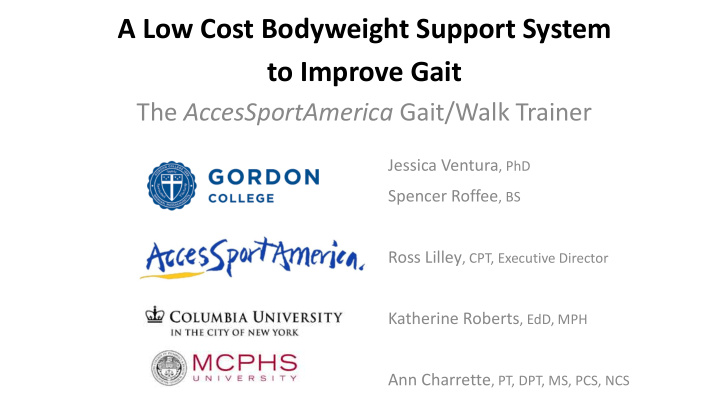



A Low Cost Bodyweight Support System to Improve Gait The AccesSportAmerica Gait/Walk Trainer Jessica Ventura , PhD Spencer Roffee , BS Ross Lilley , CPT, Executive Director Katherine Roberts , EdD, MPH Ann Charrette , PT, DPT, MS, PCS, NCS
Background • AccesSportAmerica adapts sports and trains people living with disabilities toward higher function since 1995. • Sports inspire individuals and families to see themselves as compelling athletes – driving them to train for high function. • In 20 years of training, nothing improved gait like perfect form, weight supported gait training on a treadmill.
Other Gait Training Methods Manual Method • Hand over hand manipulation with therapists sitting on side of treadmill. • Fatiguing and imprecise correction of gait. • Staff intensive. The Lokomat • High-tech solution to correct form during weight supported gait training on a treadmill • But, Expensive!
AccesSportAmerica Gait/Walk Trainer https://patents.google.com/patent/US20170281999A1
AccesSportAmerica Gait/Walk Trainer • Offers perfect form with variable stride length, hip/knee flexion, and adjustable ankle rotation. • Requires only one monitoring trainer who can also pedal to influence gait. • Inexpensive – under $5000 so individuals have access for 3-4 times/week. • Versatile – users can walk and even run safely. • Athletes can train for over an hour at time for benefits of conditioning and improving function.
Gait Study The purpose of this study was to determine the effects that training on the ASA Gait/Walk Trainer has on walking speed and joint range of motion.
Participants • Our gym consists of 4 Gait/Walk Trainers. • 16 athletes with disabilities enrolled in the study, with 11 completing it. • Participants come with a variety disabilities: – Hemiparesis (7) – Head Injury (3) – Cerebral Palsy (1) • Training Frequency: – 2 to 3 times/week – 2+ to 9 months
Testing • 10 Meter Walk Test recorded using a webcam on a trolley • Videos analyzed in Dartfish (3 trials per participant)
Change in Walking Speed • An average 22% increase in walking speed (46% in slower walkers) • Healthy walking speed = 1.1 m/s
Spatiotemporal Changes p=0.030 p=0.017 * * p=0.011 * • Increase in walking speed is largely due to decrease in step time
Walking Mechanics • The capacity to increase walking speed is limited by impaired hip and ankle power generation in lower functioning persons (doi: 10.1016/j.gaitpost.2008.07.010) • No significant differences were found in joint angles after training.
Case Study: Joey November 2017 0.29 m/s
Case Study: Joey May 2018 0.54 m/s
Case Study: Joey May 2018 Solo!
Conclusions • The ASA GaitTrainer elicits an increase in walking speed during overground walking, as a result of increased cadence. • Changes in walking technique differs between participants. – Walking will need to be assessed in the Biomechanics Lab to assess joint power generation . • More people with mobility disorders should have consistent access to the ASA GaitTrainer. – Regular exercise has a host of health benefits! – Most athletes regress during breaks in the training program.
Questions?
Regression m/s June Nov • Walking speeds of 6 participants from the 2017 study who also 1 0.37 0.30 participated in the 2018 study: 2 0.61 0.33 – 2017 study Ended: June 2017 3 0.37 0.25 – 2018 study Began: Nov 2017 • Between studies, 5 participants 4 1.99 1.29 regressed. 5 0.75 1.33 6 0.18 0.29 Avg 0.71 0.39
Recommend
More recommend